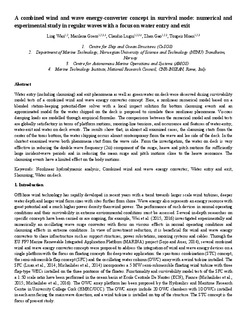| dc.contributor.author | Wan, Ling | |
| dc.contributor.author | Greco, Marilena | |
| dc.contributor.author | Lugni, Claudio | |
| dc.contributor.author | Gao, Zhen | |
| dc.contributor.author | Moan, Torgeir | |
| dc.date.accessioned | 2017-03-22T08:30:35Z | |
| dc.date.available | 2017-03-22T08:30:35Z | |
| dc.date.created | 2017-02-07T15:54:44Z | |
| dc.date.issued | 2017 | |
| dc.identifier.citation | Applied Ocean Research. 2017, 63 200-216. | nb_NO |
| dc.identifier.issn | 0141-1187 | |
| dc.identifier.uri | http://hdl.handle.net/11250/2434936 | |
| dc.description.abstract | Water entry (including slamming) and exit phenomena as well as green water on deck were observed during survivability model tests of a combined wind and wave energy converter concept. Here, a nonlinear numerical model based on a blended station-keeping potential-flow solver with a local impact solution for bottom slamming events and an approximated model for the water shipped on the deck is proposed to simulate these nonlinear phenomena. Viscous damping loads are modelled through empirical formulas. The comparisons between the numerical model and model tests are globally satisfactory in terms of platform motions, mooring-line tensions, and occurrence and features of water-entry, water-exit and water on deck events. The results show that, in almost all examined cases, the slamming starts from the center of the torus bottom, the water shipping occurs almost contemporary from the wave and lee side of the deck. In the shortest examined waves both phenomena start from the wave side. From the investigation, the water on deck is very effective in reducing the double wave frequency (2) component of the surge, heave and pitch motions for sufficiently large incident-wave periods and in reducing the mean surge and pitch motions close to the heave resonance. The slamming events have a limited effect on the body motions. | nb_NO |
| dc.language.iso | eng | nb_NO |
| dc.publisher | Elsevier | nb_NO |
| dc.title | A combined wind and wave energy-converter concept in survivalmode: Numerical and experimental study in regular waves with afocus on water entry and exit | nb_NO |
| dc.type | Journal article | nb_NO |
| dc.type | Peer reviewed | nb_NO |
| dc.source.pagenumber | 200-216 | nb_NO |
| dc.source.volume | 63 | nb_NO |
| dc.source.journal | Applied Ocean Research | nb_NO |
| dc.identifier.doi | 10.1016/j.apor.2017.01.013 | |
| dc.identifier.cristin | 1448068 | |
| dc.relation.project | Norges forskningsråd: 223254 | nb_NO |
| dc.description.localcode | ©2017 Elsevier Ltd. All rights reserved. This is the authors' accepted and refereed manuscript to the article. Locked until 28th February 2019 due to copyright restrictions | nb_NO |
| cristin.unitcode | 194,64,20,0 | |
| cristin.unitcode | 194,64,70,0 | |
| cristin.unitcode | 194,64,80,0 | |
| cristin.unitname | Institutt for marin teknikk | |
| cristin.unitname | Centre for Ships and Ocean Structures | |
| cristin.unitname | Senter for autonome marine operasjoner og systemer | |
| cristin.ispublished | true | |
| cristin.fulltext | postprint | |
| cristin.qualitycode | 1 | |
